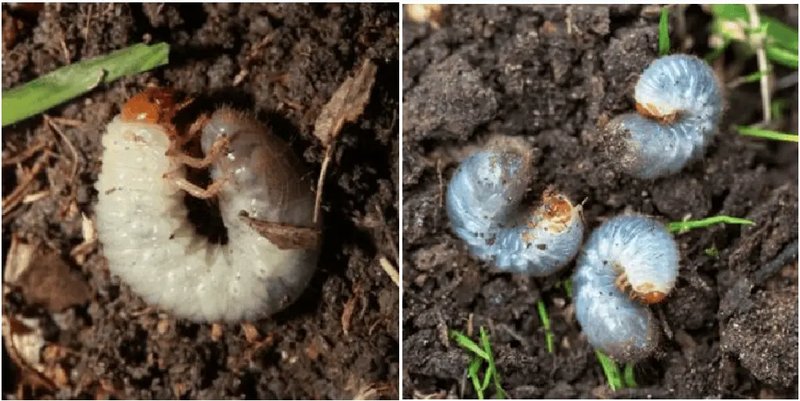
Grub worms are the larvae of various beetles, including June bugs and Japanese beetles. They thrive just below the surface of the soil, munching on the roots of your beloved grass. So, how do you spot these pesky worms before they wreak havoc on your garden? Let’s dive into the telltale signs, methods of identification, and what to do if you find them.
What Are Grub Worms?
Grub worms are the juvenile stage of scarab beetles, and they can wreak havoc on lawns and gardens if left unchecked. These little critters are usually white or cream-colored, with a C-shaped body and a soft texture. They tend to live in the soil, feeding on the roots of grass and other plants.
When you think of grub worms, imagine tiny, wriggly creatures that are just waiting for the chance to munch on your yard. If your lawn feels spongy or patches of grass are wilting, grub worms may be the culprits. Understanding what they are is crucial for treating your lawn effectively.
Signs of Grub Worm Infestation
You might be wondering how to tell if your turf is hosting these unwelcome guests. Here are some classic signs to keep an eye out for:
- Patches of Brown Grass: If you notice patches of grass turning brown or dying, this could be a sign of grub worms munching on the roots.
- Uneven Turf Texture: When you walk on your lawn, does it feel spongy or soft? That can indicate that the roots are being eaten away.
- Animal Activity: If you see birds, raccoons, or other animals digging up your lawn, they might be hunting for grub worms, which they find quite tasty.
Each of these signs can signal that your lovely turf needs a little extra attention, so keep them in mind as you inspect your yard.
How to Check for Grub Worms
Now that you know what to look for, let’s talk about the actual process of checking for grub worms. Here’s how you can do it:
1. **Dig a Small Section**: Use a trowel or a spade to dig up a small square of turf that’s about 12 inches by 12 inches. Aim for a depth of about 4–6 inches.
2. **Inspect the Soil**: Look closely at the soil you’ve dug up. Grub worms usually hide just below the surface, so you may need to sift through the soil to find them.
3. **Count the Grubs**: As a rule of thumb, if you find more than five grub worms in that section, you may have an infestation.
This quick test will give you a clear idea of whether these pests are troubling your plants, and you should feel empowered to take action if needed.
Identifying Grub Species
There are several species of grub worms, but the most common ones include the Japanese beetle grubs and the European chafer grubs. Here’s how to identify them:
– **Japanese Beetle Grubs**: These are typically about an inch long and have a distinctive curved shape. They often have a darker head and a smooth body.
– **European Chafer Grubs**: These grubs are usually similar in size but have a lighter-colored head. They tend to be more elongated and less curved than Japanese beetle grubs.
Knowing the difference between these species can help you choose the right treatment method for your lawn.
What to Do If You Find Grub Worms
If your inspection reveals a grub worm problem, it’s time to take action. Here’s what you can do:
– **Use Beneficial Nematodes**: These microscopic worms can help control grub populations naturally. They seek out pests like grub worms and can be applied to your lawn as a treatment.
– **Apply Chemical Treatments**: If the infestation is severe, you might want to consider insecticides that target grub worms. Be sure to follow the product instructions carefully for safety and effectiveness.
– **Improve Lawn Health**: Healthy grass is less susceptible to pests. Regular aeration, watering, and proper fertilization can give your lawn resilience against future infestations.
Taking these steps can help restore your yard’s beauty and keep it healthy for years to come.
Preventing Future Grub Worm Infestations
Once you’ve dealt with an infestation, you’ll want to prevent it from happening again. Here are some useful tips:
1. **Regular Lawn Maintenance**: Mow your lawn regularly and keep it well-watered. Healthy grass is better at fending off pests.
2. **Monitor for Beetles**: Since grub worms come from beetles, keeping an eye out for adult beetles in your yard can help you catch problems early.
3. **Use Organic Fertilizers**: Organic fertilizers can improve soil health without attracting pests. A well-nourished lawn is less appealing to grubs.
By taking these proactive steps, you’ll create an environment that’s less inviting for grub worms and more conducive to a lush, healthy lawn.
Identifying grub worms in soil and turf might seem daunting at first, but with a little observation and care, it becomes a manageable task. By recognizing the signs of an infestation early on and taking appropriate action, you can protect your lawn from these pesky builders of chaos.
So, next time you’re enjoying your green space, remember to keep an eye out for the signs of grub worms. With a little diligence, you’ll ensure your lawn remains the stunning oasis you love, free from unwanted pests. Happy gardening!
